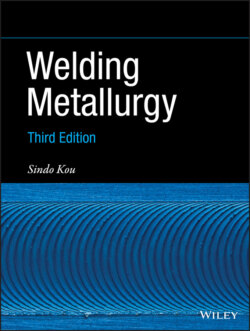Читать книгу Welding Metallurgy - Sindo Kou - Страница 10
Preface to Third Edition
ОглавлениеThe 3rd edition of Welding Metallurgy includes updates and expands the 2nd edition that was published in 2003. About half of the 3rd edition has new content. It includes the significant new progress made in welding metallurgy since 2003. To help readers understand the subjects discussed, examples are provided in each chapter. To make it easier for readers to find cited articles or judge their relevance, the titles of the articles and the full names of the journals are provided.
In Part I, Introduction, Chapter 1 has been expanded, which also includes topics on resistance spot welding and solid‐state welding (friction welding, friction stir welding, explosion welding, magnetic impulse welding, and diffusion welding). Chapter 3 includes the significant effect of metal vapor in the arc on weld penetration. It also includes the new progress made at UW‐Madison on oscillatory Marangoni flow in the weld pool, weld‐pool‐surface deformation and oscillation, weld ripple formation, and how they are affected by the surface‐active agent. Chapter 4 includes two new mechanisms proposed at UW‐Madison for spatter in gas–metal arc welding of Al and Mg alloys.
Part II, The Fusion Zone, has been restructured and expanded to include four new chapters: Chapters 10, 11, 12, and 14. Ternary alloy solidification, which is often difficult for students to understand, has been explained with the liquidus projections and solidification paths of example alloys. Part II discusses more on the following new progress made at UW‐Madison. A liquid‐metal quenching technique to “freeze‐in” and reveal the elevated temperature microstructure during welding is demonstrated, which is useful for understanding phase transformations, nucleation mechanisms, microsegregation, diffusion, etc. Bending of growing columnar dendrites without breaking is shown to support thermal instead of mechanical, dendrite fragmentation. Identification of the grain refining mechanism is demonstrated. A statistically significant measurement of microsegregation used in casting is applied to welding. Base‐metal‐like “beaches,” “peninsulas,” and “islands” surrounded by the weld metal, often found in dissimilar filler welding and dissimilar metal welding, is explained. A simple index is proposed to predict the solidification cracking susceptibility of Al and Mg alloys and how effectively filler metals can reduce the susceptibility. A simple but improved new test for evaluating the solidification cracking susceptibility of various alloys and the filler metal effectiveness is demonstrated. New theories on the resistance of austenitic stainless steels to solidification cracking and ductility‐dip cracking are presented.
Part III, The Partially Melted Zone, also discusses more on the new progress made at UW‐Madison, including liquation (liquid formation) and liquation‐induced cracking. A simple criterion is proposed to predict how filler metals can be selected in arc welding to eliminate liquation cracking. Evidence of liquation and liquation cracking in friction stir welding (FSW) is presented. In Al‐to‐Mg butt and lap FSW, the interesting and significant effect of the position of Al relative to Mg on the joint strength is explained. Interestingly, liquid droplets have been shown even though FSW is considered as solid‐state welding.
Part IV, The Heat‐Affected Zone (HAZ), has been reorganized into the following new chapters: Chapters 17, 18, 19, and 20.
Part V, Special Topics, is a new chapter. It has been added to introduce some topics of high current interest, such as Chapters 21–24. Chapters 23 and 24, and several sections in Chapter 22 discuss heavily on the new progress at UW‐Madison.
The author thanks God for giving him the opportunity and ability to do what he has done in welding metallurgy. He applied his training in transport phenomena (BS in Chemical Engineering at the National Taiwan University) and solidification (PhD in Metallurgy at the Massachusetts Institute of Technology under Professor Merton C. Flemings) to welding. His work was supported by funding from the National Science Foundation (NSF), NASA, the University of Wisconsin Foundation, the AWS Foundation, Hobart Brothers, General Motors, ALCOA, Howmet, CompuTherm, and other companies, which are greatly appreciated. The NSF support includes solidification cracking and ductility‐dip cracking in stainless steel welds under grant number DMR1904503, solidification cracking of Al alloys under grant number DMR1500367, and many other topics throughout the book (under several NSF projects since 1980).
The author is grateful to CompuTherm, founded by Professor Y. Austin Chang of UW‐Madison. Without their thermodynamic software, databases, and technical support, it would have been much more difficult for the author to develop his theories to predict liquation cracking, solidification cracking, and macrosegregation. He thanks the American Welding Society (AWS) for granting permission to use many figures and tables published in the Welding Journal and the Welding Handbook. Getting permissions is now costly for the author of a technical book. To keep the cost down, tens of figures from the work of many other researchers initially included in the manuscript had to be sadly removed.
The author acknowledges the numerous contributions to this book from his former students and associates at UW‐Madison. The hard work of some of them has been recognized with the following technical paper awards, which they shared with the author: the Warren F. Savage Memorial Award (2012, 2009, 2008, and 2006), Charles H. Jennings Memorial Award (2014, 2010, 2002, and 2001), William Spraragen Award (2019, 2016, and 2007), A.F. Davis Silver Medal Award (2017), and James F. Lincoln Gold Medal (2016) of the American Welding Society, and the Magnesium Technology Best Paper Award (2017) of The Minerals, Metals & Materials Society (TMS).
Sindo Kou
Madison, Wisconsin, 2020
